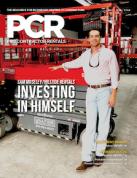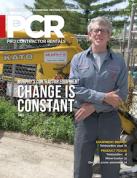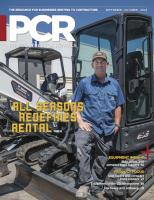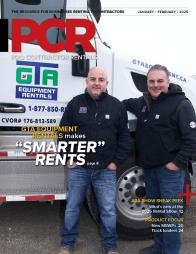Rental Center – Follow the money
Bottom Line Equipment LLC was founded in 2005 and has grown to eight service centers that stretch from New Orleans to Dallas. It’s grown by forecasting construction growth trends and capitalizing on them.
by Clair Urbain
You could say that Kurt Degueyter cut his teeth in the equipment business. “My dad was one of the first employees of a Case dealer; we lived in a house right behind the dealership,” he recalls.
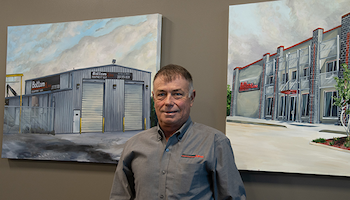 |
|
Kurt Degueyter, Bottom Line Equipment founder, in front of two paintings in the Sulphur, Louisiana service center. On the left is the original Sulphur facility; on right, the new service center that opened in 2020. |
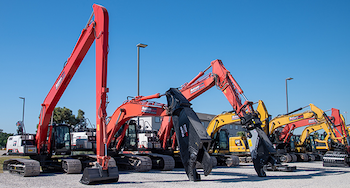 |
| As hurricane Katrina cleanup proceeded in the greater New Orleans area in 2005 and subsequent years, Bottom Line Equipment’s fleet evolved from site cleanup tools to demolition equipment that included shears, grapples and concrete breakers that fit on excavators. |
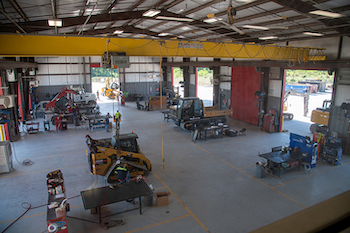 |
| Customers have come to expect top-notch specialty equipment from Bottom Line Equipment. Service centers are well equipped to handle equipment maintenance; 25 service trucks work in-field to keep equipment operating and six preventive maintenance trucks service equipment in the field, offering contractors turnkey equipment maintenance. |
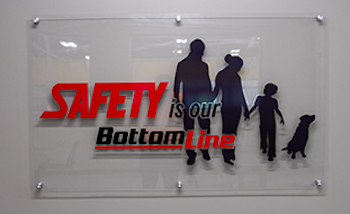 |
|
Safety is very much a part of the Bottom Line equipment culture. One of its core values is Work Hard, Smart, Safe. |
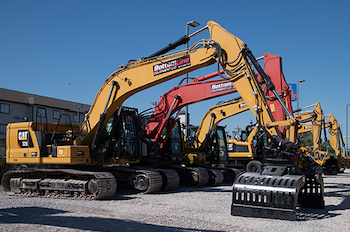 |
|
Bottom Line Equipment is known throughout the Gulf Coast as a reliable rental center that carries a wide variety of specialty attachments. Many of the pieces are paired with excavators for specific types of construction jobs. It has more than 600 specialty attachments in its fleet. |
As he grew, he worked at increasingly responsible roles in the dealership; his father ended up purchasing the business. “I started pushing a broom when I was young and when I was in my teens, worked into parts and then service work,” Degueyter says.
That was until the early ’80s when the oil business went in the tank. “I moved up to the East Coast and worked construction. I got married and had kids and realized that I didn’t want to do construction the rest of my life. I started going to school on nights and weekends.”
Once he got his bachelor’s degree, Kurt, his wife Kim and family moved back to the Lake Charles, Louisiana, area and his father hired him to be his rental salesman. “This was in the ’90s, when equipment dealers would say they were also in the rental business, but really, they were just renting trade-ins and well-used equipment. We moved new equipment into the rental fleet, and I became the rental manager. Over time, we ranked in the top 50 rental businesses in the United States.”
In 1997, Degueyter became the vice president at his father’s company and worked there until 2005, when he decided to go out on his own and build a new rental company, Bottom Line Equipment LLC.
He started brokering equipment. “I was doing okay, brokering equipment before starting Bottom Line Equipment. Just 30 days after launching the Bottom Line Equipment LLC, Hurricane Katrina hit New Orleans and I immediately saw the need to get equipment attachments that would be needed for the vast cleanup effort. We took our home equity line of credit and bought $100,000 worth of attachments and equipment; anything I could get my hands on. Within three days after Katrina hit landfall, I filled up the Suburban and trailer and headed to New Orleans. The first night, I parked in a yard of an abandoned service station on Equipment Row and made connections to rent skid steers with attachments that could be used to clear debris. We ended up making that location the base of our rental business. For three years, we lived in RVs on the site so were able to offer 24/7 service,” he says.
Hurricane Katrina was a Category 5 storm that inundated and destroyed vast areas in New Orleans. Its unprecedented damage required billions in repairs and rebuilding.
“We offered 24/7 service for equipment doing debris removal. In early 2006, with most of the debris cleared, we sold down our inventory of debris removal equipment and purchased heavier demolition equipment that included grapples, concrete breakers and shears that could be used to demolish larger projects, which was the next natural step in the recovery process. Then in 2007 and 2008, when the Army Corps of Engineers started rebuilding the hurricane protection system, we purchased heavy earthmoving equipment and rented it,” Degueyter says.
|
Bottom Line Equipment LLC at a glance 8 locations
Employees:
Equipment fleet:
Service availability:
Growth rate:
|
The Army Corps of Engineers committed billions to rebuild the levees and update the flood protection system, a massive project that would take 20 years to complete.
“We were growing right along, but then the Great Recession hit in 2008. We were asking for more capital, but it was hard to come by. We had creditors fly in and I took them on tours of the city and all the projects underway. The recovery efforts for Katrina were no longer national news and we were able to show them, firsthand how the recovery rebuilding and rebuilding of the levee systems had just begun and had a long way to go. Doing the field trips helped us gain access to capital in a very tight market.” he says.
Things were coming along nicely despite the recession, but in 2010, Degueyter started thinking about the strategic position of his business. Most of his eggs were in the basket of federally funded projects, and what would happen if that dried up? “I decided I needed to diversify our customer base,” he says.
He didn’t have to look far; the oil and gas business, which had taken a deep dive in the 1980s, was coming back to life and oil companies were gearing up for an unprecedented infrastructure improvement. Degueyter saw this as an opportunity to make slight modifications to much of Bottom Line’s earthmoving equipment and move it into rentals for the petrochemical and pipeline business.
|
Bottom Line Equipment mission: Core values: • Exhibits a can-do attitude Do the right thing Work hard, smart, safe We care Be the best Own it |
“In late 2011, we had 50 machines working on a large pipeline project in the Lake Charles, Louisiana market. We were also aware of another $14 billion in announced industrial projects and expansions in that same market. That made opening a service center in Sulphur, Louisiana our next move. By 2012, the planned industrial projects in the area had grown to $40 billion and then to $175 billion. Sulphur then served as a steppingstone into the Houston oil and gas market, and by the end of 2012 we had 150 machines working in Houston. With that level business more than two hours away, it became very apparent we needed a facility in Houston to service those customers.”
They moved into the new Baytown, Texas facility in 2013, and by the end of the year, Bottom Line Equipment had more than 300 machines on rent in the Houston area.
The next facility need was in the Baton Rouge area. “Most of the industrial facilities are located along the Mississippi River between Baton Rouge and New Orleans, so we opened a service center in Baton Rouge,” Degueyter says.
Growth continues
Following the money and the need to further diversify his business, Degueyter looked to areas where industrial construction was on the upswing. “In 2014, we opened an office for back-office functions in Lafayette and in 2015 opened our Beaumont Texas facility to better serve the Golden Triangle markets. In 2019, we opened a service center in Corpus Christi and a service center in Broussard, Louisiana in 2020.” he says.
The most recent service center location addition is in Greenville, Texas on the east side of the Dallas-Fort Worth metroplex that opened in August 2022. “The equipment rental market there is different than the Gulf Coast markets. The construction projects there are primarily more housing, infrastructure, commercial construction and solar and wind power generation. It’s a logical step in our diversification.”
Building a strategy
Degueyter, like other entrepreneurs, is always on the lookout for ways to improve his business. “I was looking for the tools and better ways to overcome the challenges of running a business day-to-day,” he says. In 2018, he decided to get involved with Peer Executive Groups, which pairs his company with other like-minded independent rental centers who are not in competition with each other. They usually meet twice a year where they share their progress, problems and plans. “We are one of the larger independent rental companies in the group, but we learn quite a bit from some of the smaller, growing companies, who often face the same problems we do. Often, their approach to a problem is more creative than what we’d do,” he observes.
Bottom Line Equipment has been consistently recognized by Peer Executive Groups’ prestigious Equipment Rental Top Gun Award. The award is presented each year to the top 25 percent of equipment rental stores based on financial performance.
Degueyter sees the Peer Executive Group as a board of directors of sorts. “It helps all involved companies to benchmark their progress and look at it on an apples-to-apples comparison. Benchmarking financials is very important because companies account for expenses differently; this system puts the financials in an easy-to-compare format.
Following the recommendations of other Peer Executive Groups participants, Degueyter has implemented the Entrepreneurial Operating System (EOS) developed by Gino Wickman to develop a game plan for his business. The book, Traction by Gino Wickman, outlines the steps involved with EOS. “After I read it, I ordered 45 copies to share with our management team. It offers a systematic approach to keep everyone working in the same direction,” he says.
“We developed a five-year growth plan using the EOS tools; it also helped us establish a company vision and core values (see sidebar).
Degueyter and his staff worked with Patrick Mchale and the team at Culture Index to learn how to apply the Culture Index tools for assessing employee strengths as they seek to develop and grow their team. “Some other Peer Group companies were using the tool and recommended it. It’s all about getting the right person in the right seat and leadership all on the same page.” he says.
“It allows us to intentionally hire and develop people to their natural strengths. For example, we have great service techs with incredible attention to detail.”
“Our growth plan helps us develop job security for everyone. It helps us set the stage to build a better community through quality work and safety. It’s a good way to help grow our employees. Through our core values, we can make good decisions and do the right thing, even if it’s the most painful thing to do. That’s good for our customers and good for our company,” Degueyter says.
“We are in the service industry, and that means long hours, especially in times of natural disasters. We have a loyal following of disaster recovery contractors that follow the storms. When a Category 4 or 5 storm hits, there is extensive long-term damage, and we are equipped to provide the specialized equipment these contractors need. We consider all our equipment as one fleet that can be accessed across all eight service centers. We have one set of standards and operate as one team. That’s our secret sauce,” he concludes.
Specialty attachment advice from Bottom Line Equipment
Bottom Line Equipment recently announced the formation of Bottom Line Pro-Fit Solutions Specialty Attachments group.
This is a team comprised of highly qualified and dedicated specialists focused on delivering unique equipment and specialty attachment solutions to Bottom Line customers. There’s a right tool for every job, and Bottom Line Pro-Fit Solutions delivers many hard-to-find specialty attachments designed to maximize productivity, profitability, and operator safety.
This article originally appeared in the November-December 2022 issue of Pro Contractor Rentals magazine. ©2022 Urbain Communications. All rights reserved.




